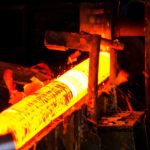Case hardening is a technique in which the metal surface is reinforced by the adding of a fine layer at the top of another metal alloy that is generally more durable. Case hardening steel is normally used to increase the object life. This is particularly significant for the manufacture of machine parts, carbon steel forgings, and carbon steel pinions. Case hardening is also utilized for other applications. Case hardening is also called surface hardening. Case hardening has been in use for many centuries, and was frequently used for producing horseshoes and different kinds of cooking utensils that were subjected to substantial wear and tear. Case hardening is essentially a group of processes that are used to increase the surface hardness to an extent that is higher than that of the bulk material. Case hardening is performed normally locally on the top surface, and for a limited depth. Greater hardness is usually related with better wear and fatigue resistance.
Case Hardening Process
The addition of carbon to the iron surfaces is common. Case hardening involves the use of metal that has low carbon contents, and combining it with a metal that has more carbon content. The grouping of metals is likely to produce the product that is much harder. The adding of the low carbon metal creates a material that can be molded easily into the desired shapes. The surface improvement not only increases the product strength, but also assists to avoid the iron weakening. Consequently, items like fireplace equipment, cast iron wash pan, and frying utensils would continue to be serviceable for long periods of time. Case hardening is frequently utilized in the constructing industry for reinforcing girders, metal doors, and metal panels. Case hardening is generally performed after the formation of the component into its ultimate form.



